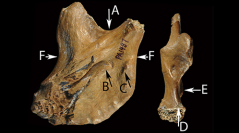

 Comptes Rendus Palevol
13 (4) - Pages 333-341
Comptes Rendus Palevol
13 (4) - Pages 333-341The earlier Late Pleistocene mandibular ramus from Xujiayao (northern China) preserves traits that vary distributionally among western Old World Pleistocene Homo samples and between Early/Middle Pleistocene archaic humans and Late Pleistocene modern humans in eastern Eurasia. Xujiayao 14 presents a lateral mandibular notch crest, an open mandibular foramen, a wide ramus, an asymmetrical mandibular notch, an enlarged superior medial pterygoid tubercle, (probably) a retromolar space, and gonial eversion, as well as an unusual depression in the planum triangulare. The first two traits appear ancestral for Later Pleistocene and recent Homo and are dominant among modern humans. The second two traits largely separate Xujiayao 14 and archaic Homo from modern humans. The next two traits are found in the highest frequency among the Neandertals, although gonial eversion contrasts with Late Pleistocene Neandertals. Xujiayao 14, in the context of Pleistocene and recent Homo samples and the other Xujiayao human remains, therefore provides a morphological mosaic, highlighting regional variation through the Pleistocene.
Mandible, China, Homo, Late Pleistocene, Late Archaic, Ramus, Neandertal